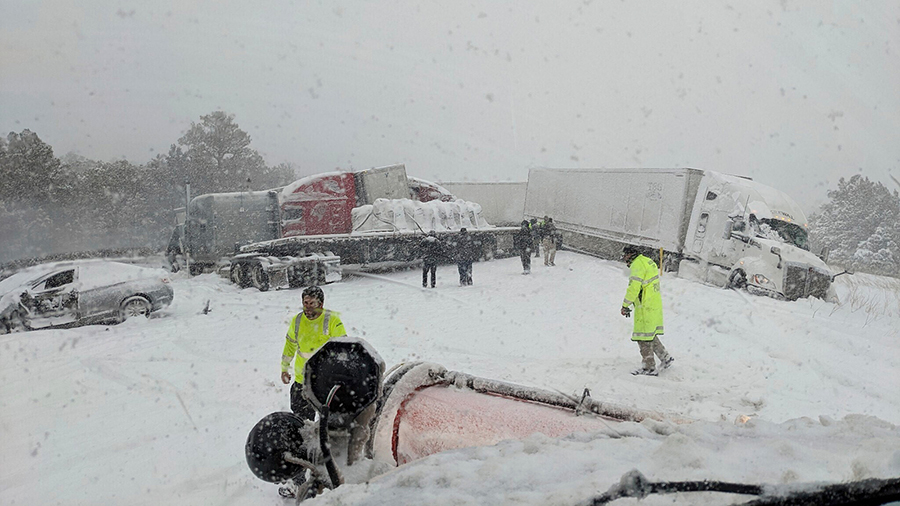Strong tornadoes and baseball-sized hail could strike Texas, Oklahoma
Mar 2, 2023, 1:40 PM

This photo provided by the Arizona Department of Transportation shows multiple vehicles snarled by a winter storm on Interstate 40 near Williams, Ariz., on Wednesday, March 1, 2023. (Arizona Department of Transportation via AP)
(Arizona Department of Transportation via AP)
(CNN) — A wide range of extreme weather is stretching across the US as storms threaten heavy snow in the Southwest and the triple threat of tornadoes, damaging winds and rain in the South.
About 35 million people across parts of the South and Southern Plains are at risk Thursday for severe thunderstorms — the worst of which could bring multiple rounds of ferocious winds, large hail and tornadoes, the Storm Prediction Center said.
“Thursday and Thursday night: An intensifying system is expected to produce significant severe storms and heavy rain that could cause flash flooding,” the National Weather Service warned. “Think now about what (to) do during a warning wherever you expect to be.”
The system is expected to trigger isolated supercell storms, which could spawn violent tornadoes and baseball-sized hail in central Texas and southern Oklahoma starting Thursday afternoon.
The parade of severe weather will move eastward Thursday evening, hurling wind gusts of up to 75 mph.
A Level 4 of 5 moderate threat of severe storms is in place for over 8 million people in eastern Texas, northern Louisiana, southwestern Arkansas and southeastern Oklahoma. Those areas include Dallas; Fort Worth, Texas; and Shreveport, Louisiana.
Memphis, Tennessee; Little Rock, Arkansas; and Waco, Texas, face a Level 3 of 5 severe storm risk. Cities with a Level 2 of 5 risk include Houston; Austin, Texas; and Jackson, Mississippi.
Torrential rainfall is also a concern. Rain could fall as quickly as 2 inches per hour in the strongest storms, leading to flash flooding.
More than 20 million people are under flood watches from Oklahoma to Ohio. Up to 5 inches of rain is forecast across the region, and isolated totals could exceed 8 inches.
The severe weather threat will shift Friday to the Southeast and Ohio Valley on Friday, with Charlotte, Nashville, Atlanta and Louisville at risk.
And the same storm system is expected to bring heavy snow and ice to the Northeast and the Great Lakes regions by this weekend.
Mammoth snowfall in the West
This lengthy winter storm already has wreaked havoc in the West, with snow in New Mexico due to continue through Thursday afternoon. Up to 5 inches is possible in lower elevations, while 8 to 18 inches could fall across high elevations.
Heavy snow Wednesday inundated the Four Corners region where Colorado, Utah, Arizona and New Mexico meet.
More than 22 inches of snow fell Wednesday in downtown Flagstaff, Arizona, according to the local weather service office.
In Southern California, massive amounts of snow this week left some stranded and made roads impassable for days. Several areas across the state saw more than 100 inches of snow, according to the National Weather Service.
The California Department of Transportation said they have so far removed over 7 million cubic yards of snow — enough to fill 2232 Olympic size swimming pools.
Across the state, about 70,000 homes and businesses still had no power Thursday morning, according to PowerOutage.us.
Across California, several days of heavy snow knocked out power to thousands, made roads impassable and trapped residents in their homes.
The California National Guard will arrive in the San Bernardino mountains on Thursday to help dig out snowbound communities, according to the state Office of Emergency Services (CalOES). Nearly 100 inches of snow have fallen on the Lake Arrowhead and Crestline communities in recent days.
Aerial footage from CNN affiliate shows neighborhoods with indiscernible streets, homes with snow reaching second-story windows, and a local supermarket whose roof completely caved in due to the heavy snow.
Gov. Gavin Newsom issued a state of emergency for 13 counties, including San Bernardino County, Los Angeles and Santa Barbara counties.
Mount Baldy, outside Los Angeles, has recorded 106 inches of snow since February 22. More than a quarter of all that snowfall came down in two days this week.
Huntington Lake in the Sierra Mountains was lashed with 144 inches of snow over a six-day period this week, according to the Fresno County Office of Emergency Services. The office also reported 10 to 12 feet of snow near China Peak, which led to the closure of Highway 16.
While California gets a brief reprieve from the snow for the rest of this week, another system is expected to move into Northern California this weekend.
The-CNN-Wire™ & © 2023 Cable News Network, Inc., a Warner Bros. Discovery Company. All rights reserved.













